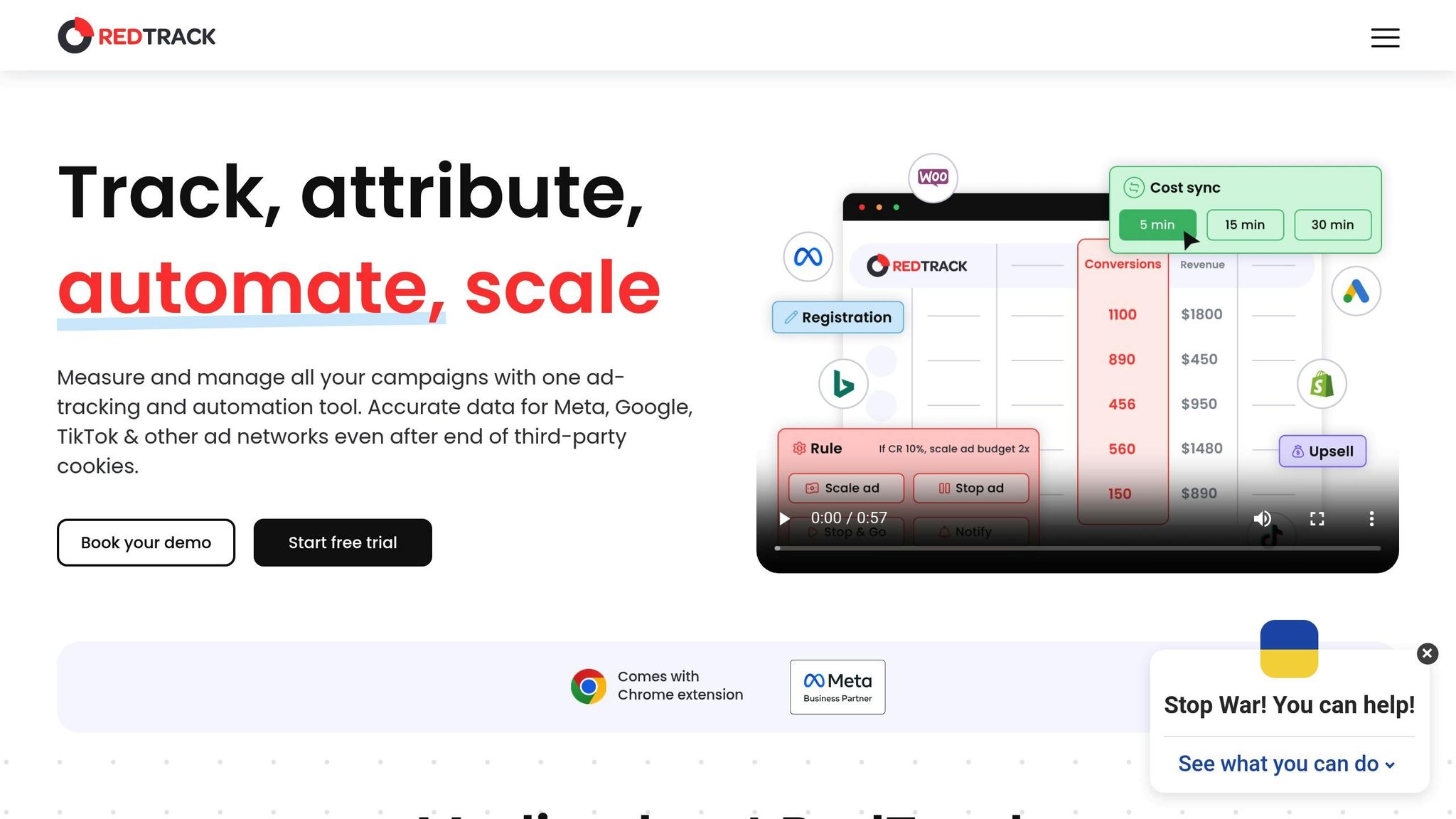Multi-device attribution connects a customer's interactions across smartphones, tablets, and desktops to provide a full picture of their journey before making a purchase. This approach helps e-commerce businesses understand how various touchpoints contribute to conversions, ensuring marketing budgets are spent effectively.
Key Points:
- Why It Matters: Customers often switch devices during their buying journey. Without multi-device tracking, businesses risk incomplete data and poorly allocated budgets.
- How It Works: Tracks users via deterministic (logins) and probabilistic (behavior patterns) methods to link interactions across devices.
- Attribution Models: Common models include Linear, Time-Decay, U-Shaped, W-Shaped, and Machine Learning-driven approaches, each assigning credit differently.
- Challenges: Privacy regulations, data fragmentation, and complex customer journeys are common obstacles.
- Solutions: Use a mix of tracking methods, invest in unified data platforms, and ensure compliance with privacy laws.
Multi-device attribution helps businesses optimize campaigns, improve ROI, and understand the true impact of marketing efforts. Below, we’ll explore methods, tools, and steps to set up an effective system.
Attribution Models and User Tracking Methods
How to Identify Users Across Devices
Connecting a single user across their smartphone, tablet, and computer is the backbone of multi-device attribution. To achieve this, businesses rely on two main methods: deterministic matching and probabilistic matching.
- Deterministic matching uses unique identifiers like login credentials or account IDs. This method is highly accurate, achieving rates of 80–90%, but it only works when users are logged in.
- Probabilistic matching, on the other hand, analyzes anonymous data such as device characteristics, browsing habits, and usage patterns. While it covers a broader audience, its accuracy falls between 60–75%.
Some businesses adopt a hybrid approach, combining both methods to improve tracking effectiveness. Tools like Google Analytics 4 (GA4) integrate these techniques for seamless cross-device tracking. To further enhance tracking, companies can encourage user authentication by implementing features like single sign-on (SSO) or social logins. Linking customer IDs through internal CRM systems also helps maintain consistent user profiles.
"Conversion rates from users who have used multiple devices before landing on the website are 230% higher compared to average."
– Aimee Blakemore, Marketing Manager, Flourish
Next, let’s look at how multi-touch attribution models expand on these user identification methods.
Multi-Touch Attribution Models Explained
Multi-touch attribution (MTA) assigns credit to multiple touchpoints in a customer’s journey, offering a clearer view of how different interactions contribute to conversions. This approach contrasts with single-touch models, which focus on just one interaction. Research shows that consumers typically engage with about six touchpoints before making a purchase.
Here’s a breakdown of common MTA models:
- Linear Model: Distributes credit evenly across all touchpoints. While it provides a complete view of the customer journey, it may lack depth.
- Time-Decay Model: Gives more credit to interactions closer to the conversion event, making it suitable for shorter sales cycles.
- U-Shaped Model: Focuses on the first and last touchpoints, balancing the importance of initial discovery and final conversion.
- W-Shaped Model: Highlights three key moments - first touch, lead conversion, and final conversion - making it ideal for complex B2B funnels.
- Data-Driven Model: Uses machine learning to allocate credit based on actual conversion patterns, adapting as customer behavior evolves.
| Attribution Model | Credit Distribution | Best For | Accuracy |
|---|---|---|---|
| Linear | Equal across all touchpoints | Full journey visibility | Medium |
| Time-Decay | More weight to recent interactions | Short sales cycles | Medium High |
| U-Shaped | Emphasizes first and last touchpoints | Balanced awareness/conversion | High |
| W-Shaped | Significant credit to key moments | Complex B2B funnels | High |
| Data-Driven | Machine learning–driven credit assignment | Large data sets | Highest |
How Credit Gets Assigned Across Devices
When customers use multiple devices in their buying journey, attribution models must distribute credit across touchpoints while maintaining accuracy. This is crucial, as 80% of marketers report budget misallocation when relying solely on first-touch or last-click attribution in multi-device campaigns.
Using deterministic and probabilistic matching, attribution models link user interactions across devices. Once these connections are established, the selected model determines how credit is distributed. For example:
- A linear model would evenly credit interactions across mobile, tablet, and desktop.
- A time-decay model might give more credit to the final desktop conversion.
- A U-shaped model would emphasize both the initial mobile interaction and the final desktop conversion.
"The challenge isn't just technical, it's strategic. When you can't accurately identify the first touch across devices, you're essentially flying blind on your most important acquisition channels."
– Marketing Attribution Research, 2025
Modern attribution systems use machine learning and predictive modeling to refine credit assignment continuously. Platforms like Adjust's Multi-touch measurement capture every pre-install interaction across channels, delivering real-time data to business intelligence systems for analysis. This ensures accurate credit distribution, even as customer journeys grow more complex.
Choosing an attribution model that aligns with your business goals and testing it through A/B experiments can help optimize your marketing strategy.
How to Set Up Multi-Device Attribution
What You Need Before Getting Started
Before diving into multi-device attribution, it's important to lay a strong groundwork. One of the biggest challenges is fragmented data - when customer information is scattered across different systems, it becomes nearly impossible to see the complete customer journey. To overcome this, you’ll need a unified commerce system that consolidates all customer interactions into a single hub.
Next, ensure that your data is ready for analysis across all marketing channels. Every channel should feed UTM parameters or similar identifiers into your analytics platform. To prevent errors, establish a clear naming convention for UTMs and enforce it using templates in tools like Google Tag Manager.
Another key step is linking customer interactions across devices. This often requires both deterministic matching (relying on login credentials) and probabilistic matching (analyzing patterns in device usage).
Don’t forget about privacy regulations. Stay compliant with laws like GDPR and CCPA by implementing strong data protection measures when collecting and analyzing customer information.
Finally, invest in data management tools to simplify the process of collecting, integrating, and analyzing data. These platforms can handle the technical challenges of connecting interactions across multiple devices.
With these essentials in place, you’re ready to move on to the implementation process.
Implementation Steps
Setting up multi-device attribution involves a step-by-step process that builds on the foundation you’ve created.
Step 1: Enable Cross-Device Tracking
Start by enabling Shopify's Customer events to ensure tracking remains intact, even on platforms like Safari and iOS that often block tracking.
Step 2: Map Your Customer Journey
Pinpoint all the ways customers interact with your brand - whether through paid ads, social media, email, website visits, or offline channels. Considering the average customer uses about 3.6 devices during their buying journey, a thorough mapping is essential.
Step 3: Implement Identity Resolution
Use an identity resolution tool to merge first-party customer IDs with device data. Partner with a trusted graph provider to link private IDs to device-specific IDs.
Once identities are resolved, it’s time to decide on an attribution model.
Step 4: Choose Your Attribution Model
Pick an attribution model that aligns with your business goals and reflects the complexity of your customer journey. Factors like your sales cycle length, the number of touchpoints, and which interactions matter most should guide your choice.
Step 5: Set Your Lookback Window
Define a lookback window to track interactions effectively. Regularly revisit this timeframe to ensure it aligns with your customers’ buying behavior.
Step 6: Configure Analytics Integration
Integrate your analytics system to capture every user interaction, from website visits to email clicks, social media engagement, and ad interactions. Push the matched audience data to platforms like your DSP, social networks, or connected TV partners.
Step 7: Test and Validate
Run parallel tracking systems during the initial phase to compare your attribution data with known conversion patterns. This helps identify any gaps or inaccuracies before fully committing to the new system.
How to Keep Your Data Accurate
Once your multi-device attribution system is up and running, maintaining data accuracy is essential to ensure your insights remain reliable. The quality of your data will determine whether your decisions lead to success or missteps.
- Start by standardizing data labels to ensure consistency in reporting and analysis.
- Regularly validate, clean, and update customer information to maintain its integrity.
- Centralize all data sources into a single platform to create a unified view of customer interactions.
- Use customer surveys to bridge gaps in offline attribution.
- Continuously monitor and refine your system to adapt to shifts in customer behavior, market trends, and new technologies.
- Establish internal guidelines for multi-touch attribution to ensure consistency across your organization.
Common Problems and How to Fix Them
Main Multi-Device Attribution Problems
Multi-device attribution comes with its fair share of challenges that can drain resources and leave you frustrated. Tackling these issues head-on can save you time and effort.
Privacy restrictions are a major roadblock. Regulations like GDPR and CCPA limit the data you can collect, which affects your ability to track customers across all their interactions. Without a full picture, it’s like trying to solve a puzzle with missing pieces.
Then there’s data fragmentation. With 73% of customers using multiple channels during their shopping journey, data gets scattered across various platforms that don’t communicate with each other. This makes it tough to piece together a cohesive view of your customer’s journey.
The complexity of modern customer journeys adds another layer of difficulty. Traditional attribution models oversimplify how people shop, ignoring the reality that customers often switch devices multiple times before making a purchase.
Resource demands are also a big concern. Implementing cross-device attribution systems isn’t just a plug-and-play operation. It requires technical expertise and a significant investment in tools and personnel. Many businesses underestimate this and find themselves overwhelmed.
Finally, inaccurate user matching can throw off your entire strategy. If your system struggles to identify users across devices or connects the dots incorrectly, your ad spend and targeting efforts suffer. Misguided decisions based on incomplete data can cost you both money and opportunities.
Solutions That Work
Fortunately, there are practical solutions to these challenges.
Adopt a first-party data strategy by encouraging users to log in with clear value-driven incentives. This approach not only improves tracking accuracy but also ensures compliance with privacy laws.
Use a unified marketing measurement platform to tackle data fragmentation. These platforms consolidate all user interactions into one system, giving you a clearer view of the customer journey. This eliminates the blind spots caused by disconnected tools.
Combine deterministic and probabilistic methods for a balanced approach. Deterministic tracking provides precise results for logged-in users, while probabilistic methods help fill in gaps for anonymous users. Together, they offer a more complete understanding of customer behavior.
Establish strong data governance policies to ensure consistent data handling. Define roles, responsibilities, and processes for managing attribution data effectively. Even the best systems won’t work without proper governance.
Regularly check data quality to keep your attribution models accurate. Automated processes for cleaning and validating data can help maintain reliability over time.
Lastly, build trust through transparency. Clear privacy policies that explain your tracking practices, along with easy opt-in and opt-out options, can encourage users to share their data. Anonymizing or aggregating data can also strike a balance between privacy and insights.
Deterministic vs. Probabilistic Methods Comparison
A combined approach to attribution blends the strengths of deterministic and probabilistic methods, addressing earlier challenges like resource demands and fragmented data.
| Feature | Deterministic Attribution | Probabilistic Attribution |
|---|---|---|
| Data Source | Unique user identifiers (email, login) | Statistical modeling, machine learning, "soft signals" |
| Accuracy | 70-80% accuracy with known identifiers | Lower accuracy, based on probability estimates |
| Implementation | Straightforward with existing data infrastructure | Complex, requires data science expertise |
| Privacy Requirements | Requires explicit user consent | Can operate with aggregated/pseudonymized data |
| Best Use Cases | High-value B2B sales, personalized campaigns | Broad reach, trend analysis, anonymous user tracking |
| Data Dependency | Relies on user logins and account creation | Works with incomplete or unavailable user data |
Deterministic attribution is ideal when you have reliable user identifiers like email addresses or login credentials. It’s highly accurate but limited to situations where users willingly share their information. This method shines for businesses with strong customer relationships and frequent logins.
Probabilistic attribution, on the other hand, uses statistical modeling to estimate user behavior based on "soft signals" like IP addresses or browser fingerprints. While less precise, it’s useful for tracking anonymous users and filling in gaps where deterministic data isn’t available.
The cost of choosing the wrong method can be steep. For instance, a probabilistic model that misattributes just 10% of conversions could lead to $5,000 in wasted spending each month - or $60,000 annually.
Katie Rigby from Ruler Analytics highlights the importance of combining these approaches:
"The debate around deterministic vs. probabilistic modelling is ongoing, but their combined use offers a more effective approach."
Successful businesses don’t pick sides - they use both. Start with deterministic tracking for logged-in users, then layer on probabilistic methods to track anonymous behavior. This hybrid approach boosts accuracy and coverage while respecting privacy laws.
If you’re unsure where to begin, tools listed in the Marketing Analytics Tools Directory can guide you toward platforms that support both methods. These platforms can help you build a comprehensive solution tailored to your tracking needs, ensuring accurate data across all customer interactions.
sbb-itb-5174ba0
Marketing Analytics Tools for Multi-Device Attribution
How Analytics Tools Improve Attribution
Marketing analytics tools are designed to simplify the complexities of multi-device attribution. By collecting and analyzing data from various marketing channels, these tools help teams make informed decisions and accurately measure performance.
Cross-device tracking is one of their key features. By using common identifiers like login details, email addresses, or even behavioral patterns, these tools can connect user actions across multiple devices. This creates a more complete view of the customer journey.
For e-commerce businesses, server-side tracking has become indispensable. This method centralizes data from different sources - such as websites, mobile apps, and offline interactions - using first-party identifiers to link user activity across devices. Unlike traditional cookie-based tracking, server-side approaches are more reliable, especially as third-party cookies are being phased out.
The financial benefits of accurate cross-device attribution are hard to ignore. Insights gained from these tools can reduce the cost per action by 30–50% and improve ROI by 50–100%. By eliminating gaps in the customer journey, businesses gain a clearer understanding of how customers interact with their brand across touchpoints.
Modern analytics platforms also harness artificial intelligence to predict user behavior and streamline data analysis. This is particularly valuable in a world where the average U.S. household owns 21 devices spanning 13 different types. AI can uncover patterns that might go unnoticed by human analysts, making these tools even more effective.
Privacy-focused tools are now the standard, ensuring user consent is respected while still delivering actionable insights. These advancements lay the groundwork for evaluating marketing analytics tools in more detail.
Using the Marketing Analytics Tools Directory
The Marketing Analytics Tools Directory makes finding the right solution easier by categorizing tools based on specific functions like real-time analytics, campaign tracking, audience insights, and cross-platform measurement.
This directory allows businesses to compare features side-by-side, helping them identify tools tailored to their needs. For example, some platforms specialize in mobile attribution tracking and fraud prevention, while others focus on cross-platform advertising attribution that accounts for external factors like competitive trends.
To make the most of the directory, businesses should focus on key criteria. It organizes tools by functionality, whether you're looking for A/B testing capabilities, business intelligence solutions, or reporting dashboards. This categorized approach simplifies the search for tools that align with your attribution needs.
Integration is another important factor. The directory highlights platforms that integrate seamlessly with your existing marketing stack, saving time and avoiding compatibility headaches. Additionally, it features tools that assign value - or "credit" - to each touchpoint in the customer journey, offering insights into how each channel influences conversions.
For businesses with mobile apps, the directory includes solutions focused on app-install attribution and identifying cross-channel traffic sources. This makes it a comprehensive resource for tackling various attribution challenges.
How to Pick the Right Tool
Choosing the right multi-device attribution tool is essential for making sense of cross-device data. Here are some key factors to consider:
- Integration Compatibility: Ensure the tool works well with your current marketing tools and e-commerce platforms.
- Device Coverage: Since internet users spend 57% of their time browsing on mobile devices and use an average of 3.6 devices, your tool must track interactions across all relevant platforms.
- Privacy and Security: With stricter privacy regulations, prioritize tools with strong security features and fraud detection to protect your data [43,47].
- Attribution Model Options: Look for tools that offer flexible attribution models. Single-touch models suit short buying cycles, while multi-touch models are better for complex journeys.
- Cost Considerations: Factor in not just the upfront cost but also onboarding, training, and maintenance expenses.
- Trial Periods: Use free trials to test features, ease of use, and whether the tool meets your needs before committing.
- Alignment with KPIs: Ensure the platform tracks metrics that matter to your business, like conversion rates or customer acquisition costs.
- Ease of Use and Training: Opt for tools with clear documentation, support resources, and user-friendly interfaces to ensure your team can use them effectively.
Remember, no single tool can solve every attribution challenge. Combining multiple approaches often yields the best results. As John Wanamaker famously said:
"Half the money I spend on advertising is wasted; the trouble is I don't know which half".
Key Points and Next Steps
Multi-Device Attribution Summary
Multi-device attribution sheds light on the customer journey by connecting nearly six touchpoints for each purchase. With 56% of consumers relying on mobile devices for research, tracking interactions across devices has become critical for e-commerce businesses. Without an effective attribution system, 80% of marketers report substantial budget misallocations, missing out on key insights for customer acquisition.
"Cross-device attribution is really about connecting the dots... Without the right attribution in place, you risk giving credit to the last touchpoint while ignoring all the earlier ones that influenced the sale".
Hybrid methods that mix deterministic and probabilistic matching offer 75–85% accuracy. This approach strikes the right balance between precision and scalability, which is essential for today's e-commerce landscape. By leveraging these advanced tracking methods, businesses can take immediate steps to refine their strategies.
What to Do Next
Here’s how you can put these insights to work and improve your attribution strategy:
- Audit your data readiness: Ensure all channels - ads, email, POS, and marketplaces - are sending UTMs to your analytics platform.
- Centralize your data: Combine data from all sources into a single platform for unified analysis.
- Standardize UTM naming conventions: Create and enforce consistent naming rules across all campaigns.
- Ensure data quality: Remove duplicates, fix errors, and standardize formats to maintain clean data.
- Select the right attribution model: Choose a model that aligns with your goals, such as linear for brand-building or time decay for revenue-focused campaigns.
- Regularly review your attribution model: Test and refine your model every quarter to keep up with market changes.
- Leverage analytics tools: Use platforms that support cross-device tracking, real-time analytics, and campaign performance evaluation.
- Train your marketing team: Help your team understand multi-touch attribution data and establish clear processes for applying insights to optimize campaigns.
Even the most advanced attribution systems won't deliver value if your team doesn't know how to act on the data. Invest in training and set up structured processes to ensure attribution insights translate into smarter budget decisions and better campaign performance.
MultiChannel Attribution 101 For Ecommerce (RedTrack and AdLeaks webinar)

FAQs
How can businesses stay compliant with privacy laws when using multi-device attribution?
To comply with privacy laws like GDPR and CCPA, businesses need to prioritize privacy-first strategies. This means focusing on practices such as using anonymized data, obtaining clear and explicit user consent, and being transparent about how data is collected and used.
On top of that, leveraging privacy-preserving technologies - like aggregated data analysis and secure storage solutions - can safeguard user information effectively. It's also essential to regularly review and update your processes to keep up with changing regulations and ensure ongoing compliance.
What are the pros and cons of using deterministic vs. probabilistic matching in multi-device attribution?
Deterministic matching is known for its high precision, typically achieving accuracy rates between 80% and 90%. It works by linking devices through unique identifiers, like logins or account information. The downside? Its reach is narrower because it depends on users being logged in across devices or consistently providing identifiable data.
On the flip side, probabilistic matching uses algorithms to estimate connections between devices based on shared behaviors or traits. This approach offers wider coverage and greater flexibility but comes with a trade-off: it’s less accurate and more prone to false positives compared to deterministic methods.
In essence, deterministic matching is the go-to for highly accurate targeting and campaigns where precision is key. Probabilistic matching, however, shines when scale matters more than exactness in connecting devices.
How do multi-touch attribution models affect marketing strategies and budget planning?
Multi-touch attribution models are essential for refining marketing strategies and making better use of budgets. By evaluating the role of various touchpoints in a customer’s journey, these models reveal which channels and campaigns contribute the most to success.
Take the time decay model as an example - it emphasizes touchpoints that occur closer to the final conversion. On the other hand, algorithmic attribution relies on data-driven analysis to assess the impact of every interaction along the way. These insights empower marketers to focus on the channels that perform best and allocate their budgets more effectively, leading to improved ROI and smarter decision-making.


